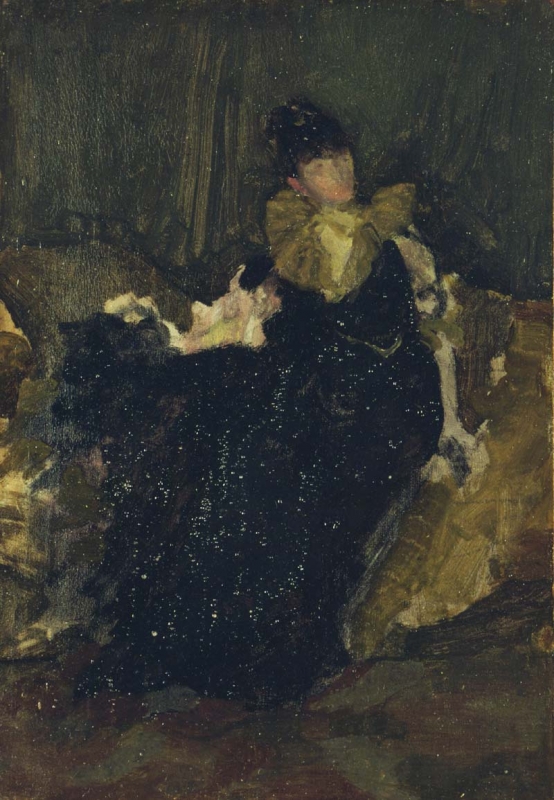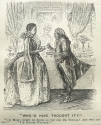The Gold Ruff probably dates from between 1885 and 1895. It is difficult to date by technique because of the deterioration of the paint surface.
The panel itself is close in size to several paintings, including The Rose Scarf [YMSM 390], The Sea, Pourville, No. 1 [YMSM 516] and Howth Head, near Dublin [YMSM 538]. Of these, The Rose Scarf – which is on a very similar panel, with similar ground – has been dated about 1890, The Sea, Pourville, No. 1 dates from the late 1890s and Howth Head, near Dublin, 1900.
The dress provides clues but some vital details are hard to distinguish. If anything it suggests a wider date range. The skirt is wide, which excludes fashionable dress of the late 1870s. The sleeves, though elaborate, are not extreme "leg o'mutton" sleeves, and this might (but does not entirely) exclude the period of 1893-1895. Broad lace collars were very common, but ruffs of this size and type (perhaps a gold mesh or chiffon with lace-type edging) were far less usual. However, a variety of ruffs are seen over a fairly wide period.
Whistler's pupil (follower, admirer) Walter Greaves (1846-1930) painted his sister Alice Fay Greaves (1852-1921) in The Green Dress (Tate Britain), which is said to date from about 1875, but even this date is not certain. Alice's dress is thought to be a Victorian revival of Elizabethan dress, and has a lightly boned broad lace ruff supported by widely spaced stiffeners, and elaborate sleeves with layers of lace trimming. These details are somewhat comparable but not exactly like those seen in The Gold Ruff.
Fancy dress – as in a 'Mary Queen of Scots' costume in a Punch cartoon of June 1885 – is an obvious source of extravagant costumes with broad stiffened ruffs. A bright pink dress worn by Queen Maud of Norway to the Duchess of Devonshire's fancy dress ball in 1897 features slashed sleeves and a fine upstanding lace collar. 1
Elaborate half- or three-quarter length sleeves were fairly common on evening and fancy dress. Examples are seen in Carolus-Duran's portrait of Queen Maria Pia of Portugal (Palacio Nacional da Ajuda, Lisbon, Portugal), and a silk and satin evening dress by Frederick Worth dating from ca 1881, with elaborate three-quarter length sleeves trimmed with lace and ribbons as well as a modest upstanding frill at the neck. 2
The dramatic appearance of Whistler's dress suggests it may have been influenced by the revivals of Renaissance or Elizabethan dress. A cartoon by Edward Linley Sambourne (1844-1910), the Betrothal of Princess Beatrice (1885), equates her with Shakespeare's Beatrice in Much Ado About Nothing, wearing mock-Elizabethan attire including an upstanding ruff – not as broad as Whistler's one, but still noticeable – and gathered and slashed sleeves, but with the fashionable addition of a bustle and a vast amount of drapery in the skirt. 3
Indeed, the dress in The Gold Ruff may literally have been a dramatic costume. Ellen Terry (1847-1928) wore spectacular ruffles and lace in several roles, including that of Letitia Hardy in Hannah Cowley's play, The Belle's Stratagem, and – more modestly – as Beatrice in Much Ado About Nothing. 4
Similarly, Sara Bernhardt (1844-1923) wore layers of lace and ruffs for her role in Victor Hugo's swashbuckling drama Marion Delorme in 1886. The Revue Illustrée shows her in a dress with half-length puffed and gathered sleeves, wide panelled skirts, a narrow belt, a fitted bodice with a square lace-trimmed neckline, and a broad wired lace ruff. 5
A later period can not be entirely excluded: in the years from 1893-1896, the expansion of sleeve width that produced "leg o'mutton" sleeves was matched by a gradual expansion of collar and ruff sizes, and the collar in The Gold Ruff may reflect this fashion, even though the sleeves do not. A 'Toilette de soirée de Mme Lipmann' created in 1893 for a passing princess ('une très élégante et très gracieuse Altesse royale') shows a very deep v-shaped corsage – another reference to Elizabethan dress – trimmed with 'pointe de Venise' (Venetian lace) that stands up like small wings at the back. 6
It was quite common for mantles and cloaks to have broad collars constructed from several layers of material gathered around the neck so that they waved attractively, setting off a blouse or dress with a smaller ruff or layers of lace at the neck. For example, the appropriate costume for a walk in the park on a fine Spring morning in 1893 was 'Capote de printemps de Mme Julia' with 'Petit collet de Mme Pelletier-Vidal' – close-fitting collars described as 'excentriques' – and a ridiculously tiny hat decorated with spring flowers. 7 It was less common to see this effect on a dress: lavish collars, yes, broad upstanding gold lace collars or ruffs, no.
Notes:
1: Pinterest website at https://www.pinterest.com/corsetobsession/back-when-u-never-saw-ankles.
2: Victoria and Albert Museum T.63&A-1976; see also an evening gown of 1882 in Detroit Historical Museum of Costume collection, 1983.039.004.
3: Punch, 10 January 1885, p. 22.
4: Albumen cabinet cards by Window & Grove, National Portrait Gallery, ca 1881 (NPG x16975) and ca 1891 (NPG x16969).
5: Maurice Barrès, 'A propos de Marion Delorme', Revue Illustrée, vol. 1, 1885-1886, p. 17, illustration by 'Myrbach', Felician von Rheinfeld-Myrbach (1853-1940).
6: 'Le Masque de Velours', 'La Vie Mondaine', Revue Illustrée, 1893, vol. 15, p. 30.
7: 'Le Masque de Velours', 'La Vie Mondaine', Revue Illustrée, 1893, vol. 15, p. 296.
Last updated: 7th December 2020 by Margaret










